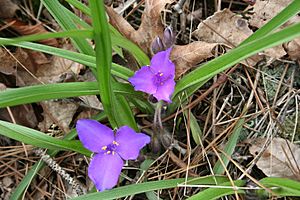Wild crocus facts for kids
Quick facts for kids Wild crocus |
|
|---|---|
 |
|
| Specimen in rocky soil on a sunny bluff in Johnson's Shut-Ins State Park, Reynolds County, Missouri, USA | |
| Conservation status | |
| Scientific classification | |
| Genus: |
Tradescantia
|
| Species: |
longipes
|
The wild crocus, also known as Tradescantia longipes, is a special plant. It's a type of plant that lives for many years. It belongs to the dayflower family. Even though it's called "wild crocus," it's not related to the true crocus flower.
This plant is only found in a specific area. It grows in the Ozark Mountains. This region covers parts of southern Missouri and northern Arkansas in the Midwest of the United States.
Contents
About the Wild Crocus
The wild crocus blooms in the spring. You can see its flowers from April to May. It likes to grow on wooded slopes. These are usually rocky hillsides.
How It Looks Different
Most other plants in the Tradescantia group have stems. These stems usually grow a few inches above the ground. But the wild crocus is different. Its flowers grow very close to the ground. They seem to pop up right from the soil!
Some other Tradescantia plants, like Tradescantia hirsuticaulis and Tradescantia virginiana, can also have short stems. But the wild crocus has its own unique features.
Identifying the Wild Crocus
You can tell Tradescantia longipes apart from Tradescantia hirsuticaulis. The wild crocus has longer flower stalks. These are called pedicels. Its small leaf-like parts, called bracts, do not have fine hairs.
It's also different from Tradescantia virginiana. The wild crocus has some sticky hairs on its sepals. Sepals are the green parts that protect the flower bud.
Another big difference is its chromosomes. Tradescantia longipes is a tetraploid plant. This means it has four sets of chromosomes in its cells. Tradescantia hirsuticaulis is a diploid plant. It only has two sets of chromosomes. Tradescantia virginiana can be both diploid or tetraploid. But where it grows near Tradescantia longipes, it's usually tetraploid too.
Plant Family Connections
Scientists study plant DNA to understand how they are related. A study looked at the DNA of Tradescantia longipes. It showed that this plant is closely related to most other Tradescantia species found in North America. These are often called the "erect Tradescantia" plants.
Growing Your Own Wild Crocus
You can grow Tradescantia longipes in your garden. It has beautiful flowers. It's a great choice for rock gardens. It also fits well in native plant gardens. These gardens use plants that naturally grow in the area.
Best Growing Conditions
The wild crocus likes partial shade. This means it needs some sunlight but also some shade during the day. It can grow in soil that doesn't have many nutrients. But it prefers soil that is a bit acidic. The soil should also be medium-moist and drain water well. This means water doesn't sit around its roots.
Caring for Your Plant
These plants grow in clumps. You can divide these clumps if you want to make more plants. After the flowers fade, the leaves might start to die back. It's a good idea to cut the plant back at this time. This helps new leaves grow. It might even encourage the plant to flower again in the autumn!


